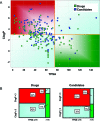Moving beyond rules: the development of a central nervous system multiparameter optimization (CNS MPO) approach to enable alignment of druglike properties
- PMID: 22778837
- PMCID: PMC3368654
- DOI: 10.1021/cn100008c
Moving beyond rules: the development of a central nervous system multiparameter optimization (CNS MPO) approach to enable alignment of druglike properties
Abstract
The interplay among commonly used physicochemical properties in drug design was examined and utilized to create a prospective design tool focused on the alignment of key druglike attributes. Using a set of six physicochemical parameters ((a) lipophilicity, calculated partition coefficient (ClogP); (b) calculated distribution coefficient at pH = 7.4 (ClogD); (c) molecular weight (MW); (d) topological polar surface area (TPSA); (e) number of hydrogen bond donors (HBD); (f) most basic center (pK(a))), a druglikeness central nervous system multiparameter optimization (CNS MPO) algorithm was built and applied to a set of marketed CNS drugs (N = 119) and Pfizer CNS candidates (N = 108), as well as to a large diversity set of Pfizer proprietary compounds (N = 11 303). The novel CNS MPO algorithm showed that 74% of marketed CNS drugs displayed a high CNS MPO score (MPO desirability score ≥ 4, using a scale of 0-6), in comparison to 60% of the Pfizer CNS candidates. This analysis suggests that this algorithm could potentially be used to identify compounds with a higher probability of successfully testing hypotheses in the clinic. In addition, a relationship between an increasing CNS MPO score and alignment of key in vitro attributes of drug discovery (favorable permeability, P-glycoprotein (P-gp) efflux, metabolic stability, and safety) was seen in the marketed CNS drug set, the Pfizer candidate set, and the Pfizer proprietary diversity set. The CNS MPO scoring function offers advantages over hard cutoffs or utilization of single parameters to optimize structure-activity relationships (SAR) by expanding medicinal chemistry design space through a holistic assessment approach. Based on six physicochemical properties commonly used by medicinal chemists, the CNS MPO function may be used prospectively at the design stage to accelerate the identification of compounds with increased probability of success.
Keywords: CNS MPO; CNS candidates; CNS drugs; Harrington optimization; Madin−Darby canine kidney; Multiparameter optimization (MPO); P-glycoprotein; Unbound intrinsic clearance; cellular toxicity; central nervous system (CNS); desirability score; dofetilide binding; drug−drug interactions; high-throughput screening; human liver microsome stability; hydrogen bond donor; lipophilicity; molecular weight; most basic pKa; multivariant optimization; passive permeability; polarity; topological polar surface area; transformed human liver epithelial cells.
Figures










References
-
- Kola I.; Landis J. (2004) Opinion: Can the pharmaceutical industry reduce attrition rates?. Nat. Rev. Drug Discovery 3, 711–716. - PubMed
-
- Leeson P. D.; Springthorpe B. (2007) The influence of drug-like concepts on decision-making in medicinal chemistry. Nat. Rev. Drug Discovery 6, 881–890. - PubMed
-
- Abad-Zapatero C. (2007) Ligand efficiency indices for effective drug discovery. Expert Opin. Drug Discovery 2, 469–488. - PubMed
-
- Keserue G. M.; Makara G. M. (2009) The influence of lead discovery strategies on the properties of drug candidates. Nat. Rev. Drug Discovery 8, 203–212. - PubMed
-
- Kalgutkar A. S. (2008) Role of bioactivation in idiosyncratic drug toxicity: Structure-toxicity relationships. Biotechnol.: Pharm. Aspects 9, 27–55.
MeSH terms
Substances
LinkOut - more resources
Full Text Sources
Other Literature Sources
Research Materials
Miscellaneous

